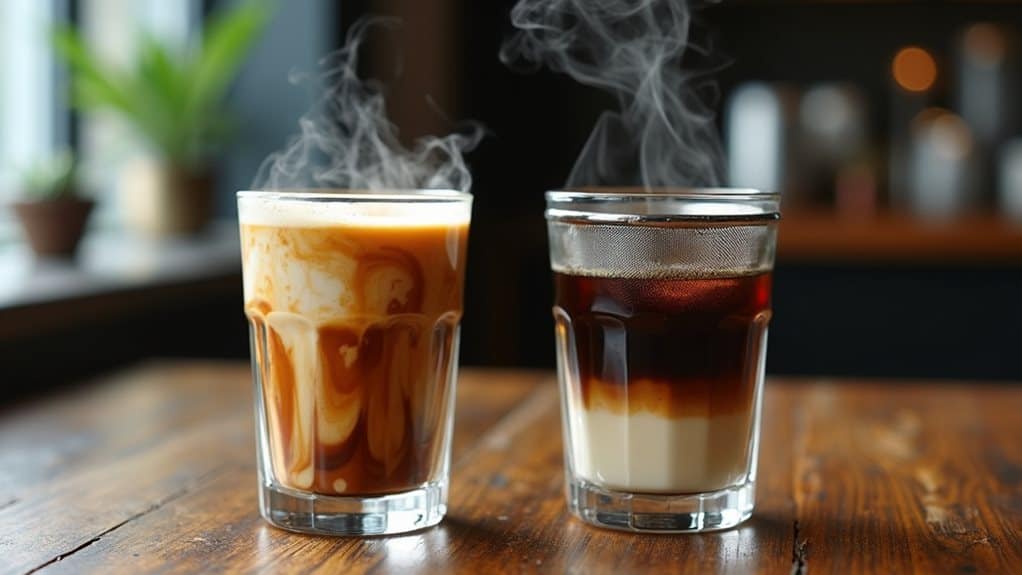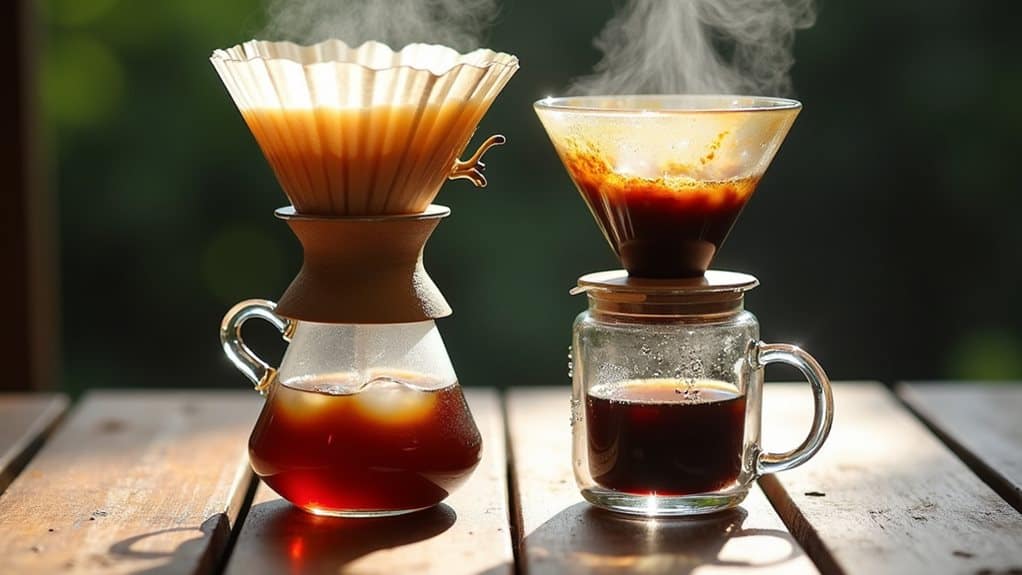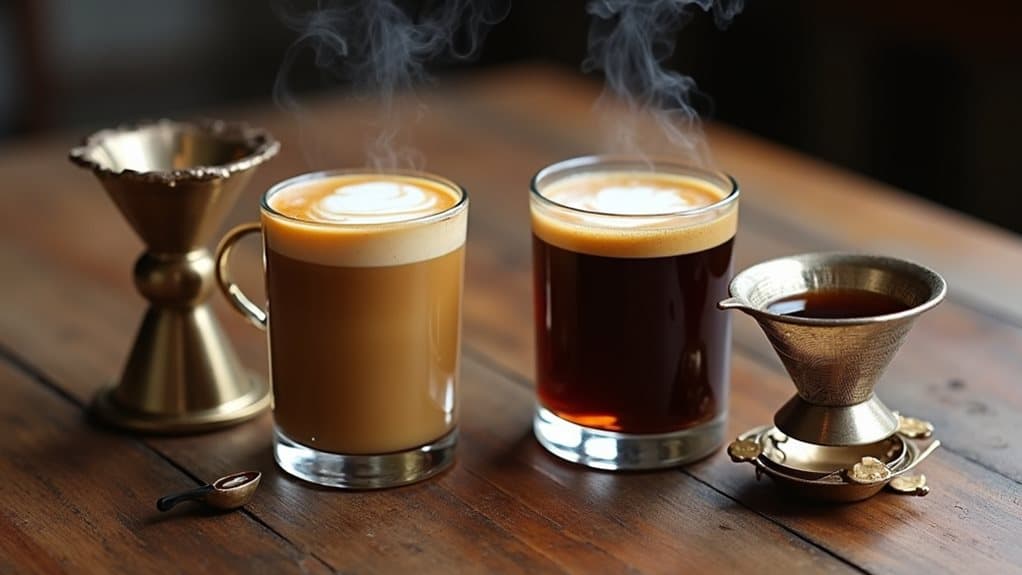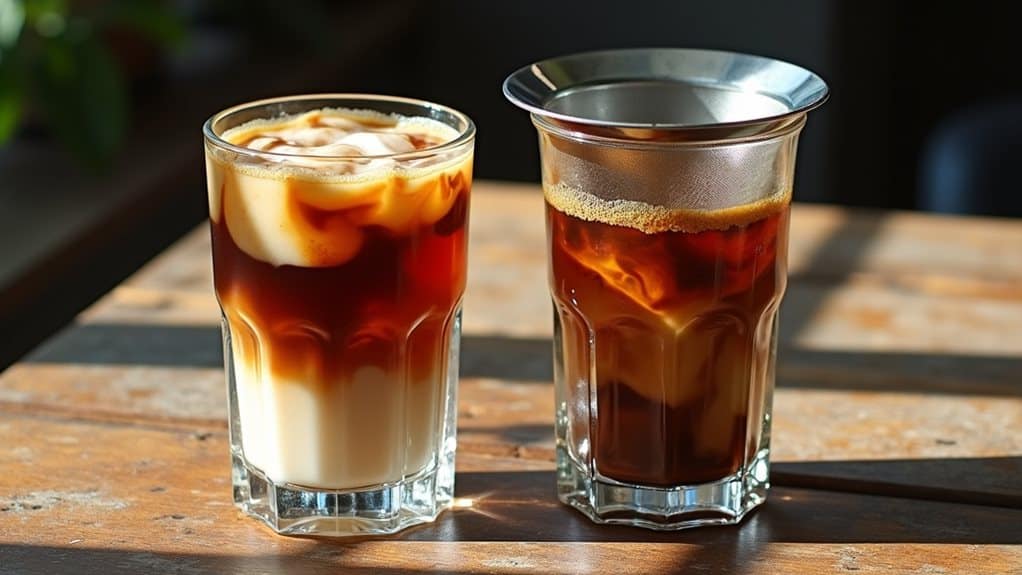When you compare Thai and Vietnamese coffee, you’ll find distinct flavor experiences shaped by their unique brewing methods. Thai coffee offers a lighter, spice-infused profile with fruity notes, using a blend of Arabica and Strong beans filtered through cloth. Vietnamese coffee delivers a bolder, more intense taste with chocolate undertones, primarily using Strong beans in a phin filter. Both styles incorporate sweetened milk, but their preparation and cultural significance create two completely different coffee journeys.
Quick Guide
- Vietnamese coffee delivers bold chocolate notes with intense flavors, while Thai coffee offers lighter, fruity, and nutty characteristics.
- Thai coffee incorporates aromatic spices like cardamom and cinnamon, creating a complex flavor profile with less bitterness.
- Vietnamese coffee uses predominantly Robusta beans for stronger taste, while Thai coffee blends Arabica and Robusta for balanced flavor.
- Thai coffee’s cloth filter method produces a smoother, syrupy body compared to Vietnamese phin filter’s full-bodied, concentrated brew.
- Vietnamese coffee typically includes sweetened condensed milk, creating a rich, creamy finish absent in traditional Thai preparations.
The Rich History Behind Two Coffee Giants

While both Thai and Vietnamese coffee have become global powerhouses today, their paths began quite differently in Southeast Asia.
You’ll find Vietnam’s coffee story starting in the 1850s with French colonists, while Thailand’s expedition began later in the 19th century under King Rama V’s initiative. Coffee beans are cultivated in both regions, contributing to their unique flavor profiles.
Western missionaries introduced coffee cultivation to Northern Thailand, laying the foundation for the country’s coffee industry.
The French shaped Vietnam’s distinctive phin filtration method, and Thailand’s Royal Project Foundation changed northern regions into thriving coffee hubs.
Bean Selection: A Tale of Two Varieties
When you compare Thai and Vietnamese coffee, you’ll notice a stark contrast in their bean selection that shapes their distinct flavors.
Vietnamese coffee growers stick mainly to Robusta beans, which create a bold, intense brew with higher caffeine content and sometimes bitter notes.
Thai coffee makers, on the other hand, typically blend both Arabica and Robusta beans, resulting in a more balanced cup that combines Arabica’s smoothness with Robusta’s power. Thai growers primarily cultivate their coffee in high-altitude regions, particularly in areas like Chiang Mai and Chiang Rai, where the mountainous terrain creates ideal growing conditions. The Arabica coffee variety is known for its sweeter and more complex flavor profile, making it a prized choice for many coffee enthusiasts.
Robusta’s Bold Dominance
Although both Thai and Vietnamese coffee cultures have unique characteristics, strong beans reign supreme in Vietnamese coffee production, shaping its distinctive bold flavor profile.
You’ll find Robusta coffee dominates Vietnamese coffee making, providing a powerful punch with 2.2-2.7% caffeine content.
While Thai coffee often uses lighter blends and varied ingredients, Vietnamese coffee’s Robusta-forward approach creates an intensely rich, earthier experience.
Arabica’s Subtle Notes
In contrast to Robusta’s bold presence, Arabica beans offer a more subtle experience in Vietnamese coffee production.
You’ll find these refined beans growing in Vietnam’s highland regions, particularly in Cau Dat, Da Lat, where the cool climate and high altitude create perfect conditions.
Vietnamese Arabica varieties like Typica and Bourbon deliver delicate floral aromas, tropical fruit notes, and a sweet, wine-like finish.
Brewing Methods That Shape the Experience

Despite sharing regional proximity, Thai and Vietnamese coffee brewing methods showcase distinct approaches that greatly influence their final taste profiles.
You’ll find Thai coffee relies on cloth filters or muslin bags with a 4-5 minute steep, while Vietnamese coffee’s signature phin filter creates a methodical drip brew.
These differences affect strength and flavor, with Vietnamese coffee typically producing a more full-bodied cup. Steeping coffee allows for a different flavor profile due to prolonged contact time between water and grounds.
Signature Flavor Profiles Compared
The rich flavor profiles of Thai and Vietnamese coffee tell distinct stories of their cultural origins and production methods.
You’ll find Thai coffee offers fruity and nutty notes with a light, syrupy body, while Vietnamese coffee delivers a bold, intense experience with chocolate undertones. Thai producers use innovative techniques like honey processing and wine yeast fermentation, whereas Vietnamese coffee relies on traditional roasting methods. Additionally, Vietnamese coffee is celebrated for its rich chocolate notes, which enhance its unique flavor profile.
Cultural Impact on Coffee Traditions

While both Thai and Vietnamese coffee cultures emerged from different historical roots, they’ve evolved into rich traditions that deeply influence daily life in Southeast Asia.
You’ll find Thai coffee enthusiasts gathering at street-side cafes with their tungdtom-filtered brews, while Vietnamese coffee lovers connect over their signature phin-filtered coffee.
Both cultures share coffee’s central role in hospitality and social bonding.
The Sweet Science of Coffee Add-ins
Both Thai and Vietnamese coffee cultures share a fascinating relationship with coffee add-ins, which extend far beyond simple flavor enhancement.
While you’ll find sweetened condensed milk as a staple in both styles, they differ in their complementary ingredients.
Thai coffee incorporates aromatic spices like cardamom and cinnamon, while Vietnamese coffee relies more on the strong flavor of its beans to balance the sweetness.
Health Benefits and Considerations

Understanding the health implications of Thai and Vietnamese coffee reveals a complex balance of benefits and considerations for regular consumers.
You’ll find these beverages rich in antioxidants that protect against chronic diseases and enhance your energy levels.
However, you’ll need to watch their high sugar content from sweetened condensed milk, and be mindful of caffeine levels, particularly in Vietnamese coffee.
Finding Your Perfect Cup: Taste Preferences
To find your perfect cup between Thai and Vietnamese coffee, you’ll want to contemplate whether you prefer the complex, spice-forward notes of Thai coffee or the bold, pure coffee intensity of Vietnamese brews.
If you enjoy aromatic spices and herbs mixed with your coffee, Thai coffee’s blend of cardamom and other seasonings might be your ideal choice, while Vietnamese coffee offers a more straightforward but strong coffee experience.
You can investigate both styles hot or iced, with Vietnamese coffee particularly renowned for its invigorating iced variation using sweetened condensed milk.
Sweetness vs. Bold Intensity
When choosing between Thai and Vietnamese coffee, your taste preferences for sweetness and bold intensity play an essential role in finding your perfect cup.
Vietnamese coffee offers a bolder, more intense experience with higher sweetness from condensed milk, while Thai coffee provides a more balanced profile.
If you enjoy strong coffee with pronounced sweetness, you’ll likely prefer Vietnamese, whereas Thai coffee suits those seeking subtle complexity.
Spice-Forward or Pure Coffee
Your expedition through coffee flavors takes a distinctive turn as you investigate the fundamental differences between spice-forward Thai coffee and pure Vietnamese coffee.
You’ll find Thai coffee often incorporates cardamom and star anise, creating an aromatic complexity, while Vietnamese coffee showcases the natural strength of its beans without added spices.
The brewing methods support these differences – Thai’s cloth filter accommodates spices, while Vietnam’s phin filter emphasizes pure coffee intensity.
Hot Versus Iced Options
Deciding between hot and iced versions of Thai and Vietnamese coffee opens up a world of distinct flavor experiences and brewing techniques.
You’ll find Thai hot coffee offers rich, dark flavors with spice additions, while Vietnamese hot coffee delivers a strong, smooth profile.
For iced options, Thai coffee presents a milder, creamier taste using both condensed and evaporated milk, whereas Vietnamese iced coffee provides a more concentrated, intense experience.
Wrapping Up
Whether you prefer Thai or Vietnamese coffee, you’ll find each style offers a unique experience rooted in rich cultural traditions. Your choice might depend on whether you enjoy Thai coffee’s balanced sweetness with cardamom notes or Vietnamese coffee’s bold, dark chocolate undertones. Consider experimenting with both brewing methods and traditional add-ins to uncover which style aligns with your taste preferences. Both options deliver satisfying caffeine enhancements with distinct flavor profiles.

